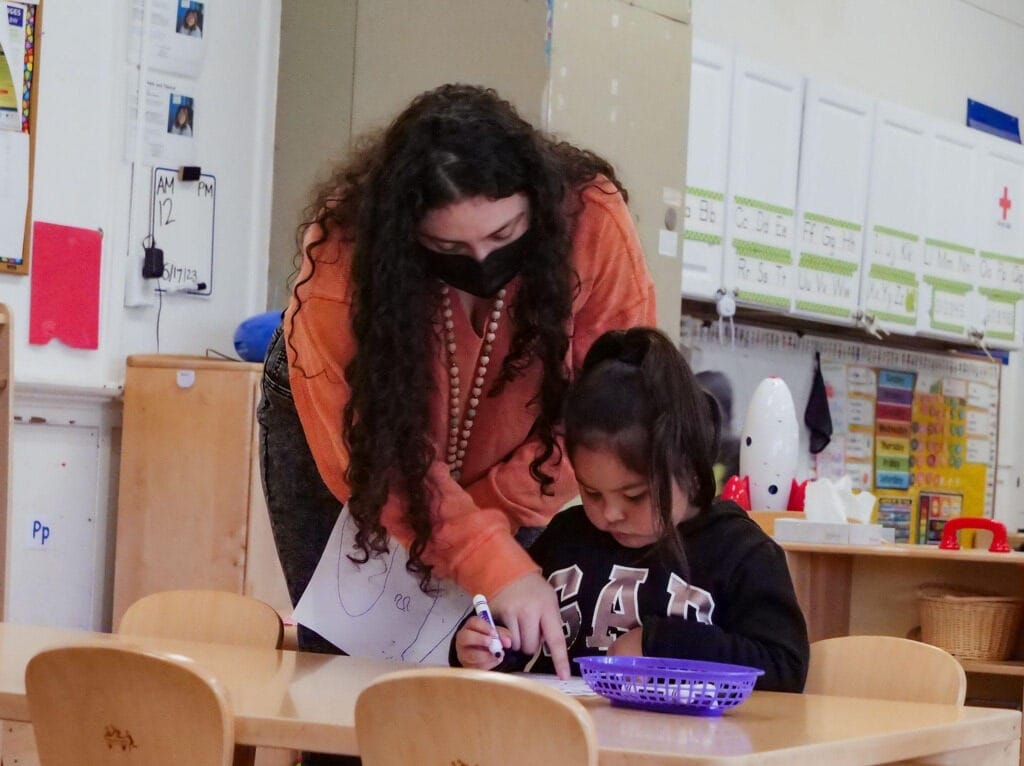Much as the environment of an early childhood setting can promote or inhibit children’s learning, a teacher’s work environment can either promote or inhibit the development of her practice.
In all fields, a rewarding and supportive work environment is critical to attracting and retaining competent and dedicated employees. The early care and education profession is no different. Yet many ECE teachers work in environments that compensate them poorly, and receive little encouragement and support for continuing to build their professional skills.
Many studies of early care and education programs have shown that various aspects of the work environment–such as high rates of teacher or director turnover, the absence of well-prepared co-workers, stress, and economic insecurity fueled by low pay–prevent teachers and programs from offering optimal care and instruction for young children.[1] Yet, too often, the workplace context of teaching young children–what teachers need in addition to training and education in order to succeed–receives minimal, if any, attention in professional development programs or quality improvement efforts in the ECE field.[2]
Resignation to low pay and limited resources has fueled silence about how to improve early childhood jobs and has stunted the growth of a vocabulary to describe the characteristics of supportive learning environments for early childhood practitioners. Mentors, coaches, trainers and other technical assistance providers hold a unique perspective about teachers’ learning environments, situated as they are at the nexus where children are taught and cared for, where teachers and providers are educated and trained, and where early education policy is made. They can help bring the voices of those who work daily with children into the discussion of how to improve services for all young children by drawing attention to the adult learning environments in early childhood settings. A starting point is to consider whether settings:
- Provide adequate teaching supports such as:
- A clearly identified curriculum framework
- A process for observing and assessing children
- Sufficient and age-appropriate classroom equipment and supplies
- Adequate numbers of staff to children
- Consistent classroom, staff and child assignments
- Access to support services for children and families
- Offer opportunities for teachers to share ideas and learn from one another
- Encourage staff to explore new ideas about teaching
- Foster initiative and teamwork among teaching staff
- Support teachers’ economic and physical well-being, by providing adequate compensation, health benefits, and paid sick leave and vacation
- Treat teachers fairly
- Include program leaders who are familiar with your protégé’s teaching, knowledgeable about early childhood curriculum and teaching young children, and actively involved in learning themselves
The Center for the Study of Child Care Employment at the University of California, Berkeley, has developed an assessment tool–Supportive Environmental Quality Underlying Adult Learning (SEQUAL)–to examine teaching and learning environments for adults in early care and education settings, based on an extensive review of research and theory about adult development, teacher education, organizational effectiveness, job satisfaction, and workplace stress.[3] It is an online survey completed by all teaching staff in a given classroom or program, leading to an overall classroom or program rating.
The SEQUAL is designed as a multi-purpose tool, to be used in technical assistance, research and education tool. Some mentoring or coaching programs may administer the SEQUAL to determine a program’s readiness to engage in a quality improvement effort. As an educational and research tool, the SEQUAL can familiarize a variety of early care and education stakeholders–such as directors, teacher educators, mentoring program coordinators, parents, policy makers and funding agencies–with concepts and best practices that teachers themselves identify as promoting their professional growth and development. The intent of SEQUAL is to raise awareness about policies, practices and relationships in the early care and education workplace that foster good environments for young children. SEQUAL ratings can generate evidence linking good teaching with meeting teachers’ needs, and can provide a basis for discussing how ECE programs can improve learning environments for teaching staff.
CSCCE is currently completing validation studies of the SEQUAL. Look for published reports on SEQUAL in the second half of 2014 or for more information, email cscceinfo@berkeley.edu. Please include “SEQUAL” in the subject line.
For more information for how mentors and coaches can support adult learning environments, check out Supporting Teachers as Learners: A guide to mentors and coaches in early care and education, available at Red Leaf Press.
Notes
1. Cost, quality and child outcomes in child care centers, technical report. (1995). (S. W. Helburn Ed.). Denver, CO: University of Colorado at Denver Department of Economics Center for Research in Economic and Social Policy.; Whitebook, M., & Sakai, L. (2003). Turnover begets turnover: An examination of job and occupational instability among child care center staff. Early Childhood Research Quarterly, 18, 273-293.; Whitebook, M., & Sakai, L. (2004). By a thread: How child care centers hold on to teachers, how teachers build lasting careers. Kalamazoo, MI: Upjohn Institute for Employment Research.; Whitebook, M., Sakai, L., Gerber, E., & Howes, C. (2001). Then & now: Changes in the child care staffing, 1994-2000. Washington, DC: Center for the Child Care Workforce and Berkeley CA: Center for the Study of Child Care Employment University of California at Berkeley.
2. Whitebook, M., & Ryan, S. (2011). Degrees in context: Asking the right questions about preparing skilled and effective teachers of young children NIEER Policy Brief. New Brunswick, NJ: National Institute for Early Education Research.
3. Ryan, S., & Whitebook, M. (2012). More than teachers: The early care and education workforce. In R. E. Pianta (Ed.), Handbook of Early Childhood Education. New York, NY: Guilford Press.


